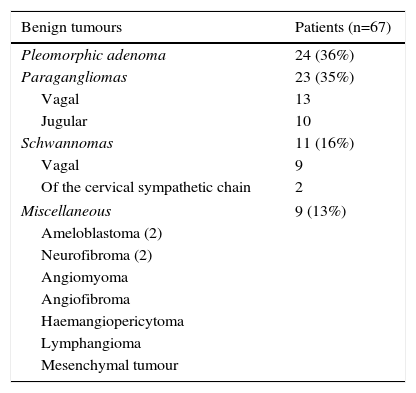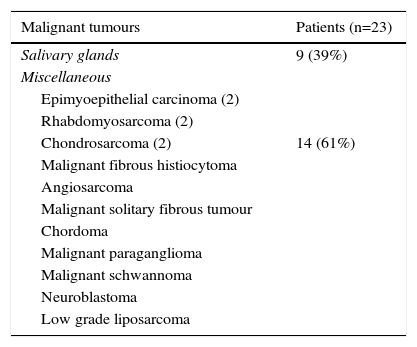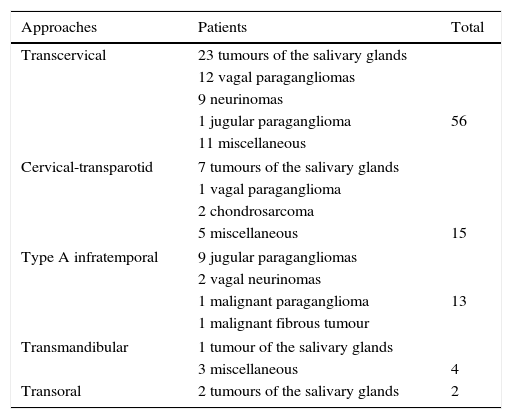The aim of this study is to present our experience with the diagnostic and therapeutic approaches for parapharyngeal space tumours.
Patients and methodThis study is a retrospective review of 90 patients diagnosed with tumours of the parapharyngeal space and treated surgically between 1984 and 2015. Patients whose tumours were not primary but invaded the parapharyngeal space expanding from another region, tumours originating in the deep lobe of the parotid gland and head and neck metastasis were excluded from this study.
Results74% percent of the parapharyngeal space neoplasms were benign and 26% were malignant. Pleomorphic adenoma was the most common neoplasm (27%), followed by paragangliomas (25%), miscellaneous malignant tumours (16%), neurogenic tumours (12%), miscellaneous benign tumours (10%), and malignant salivary gland tumours (10%). The transcervical approach was used in 56 cases, cervical-transparotid approach in 15 cases, type A infratemporal fossa approach in 13 cases, transmandibular approach in 4 cases and transoral approach in 2 cases. The most common complications were those deriving from nervous injuries.
ConclusionsMost parapharyngeal space tumours can be removed surgically with a low rate of complications and recurrence. The transcervical approach is the most frequently used.
El objetivo de este estudio es presentar nuestra experiencia en el diagnóstico y tratamiento de los tumores parafaríngeos.
Pacientes y métodoRealizamos un estudio retrospectivo de 90 pacientes, diagnosticados y tratados quirúrgicamente de una tumoración parafaríngea entre 1984 y 2015. Fueron excluidos los pacientes cuyos tumores no eran primarios, sino que invadían esta región por contigüidad, los tumores originados en el lóbulo profundo de la parótida y las metástasis de otros tumores de cabeza y cuello.
ResultadosEl 74% de las neoplasias del espacio parafaríngeo fueron de naturaleza benigna y el 26% maligna. Los adenomas pleomorfos fueron los tumores más frecuentes (27%), seguido por los paragangliomas (25%), un grupo de tumores de origen misceláneo de naturaleza maligna (16%), los tumores de origen neurogénico (12%), un grupo de tumores de origen misceláneo de naturaleza benigna (10%) y los tumores malignos de glándulas salivales (10%). El tratamiento fue quirúrgico en todos los casos. Se realizó un abordaje transcervical en 56 pacientes, un abordaje cervical-transparotídeo en 15 pacientes, un abordaje infratemporal tipo A en 13 pacientes, un abordaje transmandibular en 4 pacientes y en 2 casos un abordaje transoral. Las complicaciones más frecuentes fueron las derivadas de lesiones de estructuras nerviosas.
ConclusionesLa mayoría de los tumores localizados en el espacio parafaríngeo son subsidiarios de ser tratados de forma quirúrgica con una baja tasa de complicaciones y recurrencias. El abordaje transcervical es el más utilizado.











